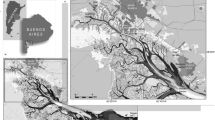Abstract
This study aimed to establish a baseline data on regression of the levels of Lead (Pb), Nickel (Ni) and Vanadium (V) to specific size dimensions of selected marine organisms harvested from an oil spill zone of the Eastern Mediterranean Sea. Twenty samples of each of Siganus rivulatus, Mullets and oysters were collected from each of six harvest sites. A total of 1, 3, and 3 respective significant regression equations (p < 0.01) were established between Pb, Ni, V and specific size dimensions of the selected marine organisms. The significant correlation associated with the highest R 2 value was obtained between the Pb (y) level and the width (x) of the Siganus rivulatus (y = −86.833x + 417.72). The other six statistically significant correlations were associated with lower values of R 2 ranging between 0.338 and 0.380. This baseline data will be used in the future to evaluate the self-purification process of pollutants in different sizes of indicator-marine organisms in this part of the Mediterranean Sea.
Similar content being viewed by others
References
Agency for Toxic Substances & Disease Registry (ATSDR) (1993) Toxicological profile for vanadium. http://www.atsdr.cdc.gov/toxprofiles/tp58.pdf. Accessed 17 Sept 2007
Agency for Toxic Substances & Disease Registry (ATSDR) (1999) Toxicological profile for lead. http://www.atsdr.cdc.gov/toxprofiles/tp13.pdf. Accessed 17 Sept 2007
Agency for Toxic Substances & Disease Registry (ATSDR) (2006) Toxicological profile for nickel. http://www.atsdr.cdc.gov/toxprofiles/tp15.pdf. Accessed 17 Sept 2007
Barbour K, Nabbut H, Al-Nakhli M (1986) Reduction of bacterial contamination in sewage effluents and soils of Saudi Arabia: impact of sewage treatment technology and natural self-purification. In: Alani DI, Moo-Young M (eds) Applied microbiology biotechnology. London and New York, Elsevier Applied Science Publishers, pp 241–250
Barbour K, Codsi J, Zurayk A (2004) Reproducibility of bacterial and copepod density assessment in bathing and artisanal fishing water of the Eastern Mediterranean. Int J Environ Health Res 14:315–321. doi:10.1080/09603120410001725658
Budzinki H, Mazéas O, Tronczynski J, Désaunay Y, Bocquené G, Claireaux G (2004) Link between exposure of fish (Solea solea) to PAHs and metabolites: application to the “Erika” oil spill. Aquat Living Resour 17:329–334. doi:10.1051/alr:2004040
Casas S, Bacher C (2006) Modeling trace metal (Hg and Pb) bioaccumulation in the Mediterranean mussel, Mytilus galloprovincialis, applied to environmental monitoring. J Sea Res 56:168–181. doi:10.1016/j.seares.2006.03.006
Chiffoleau JF, Barats LC, Dufour AC (2004) Nickel and vanadium contamination of benthic invertebrates following the “Erika” wreck. Aquat Living Resour 17:273–280. doi:10.1051/alr:2004032
Lasrado A, Santerre R, Zajicek L, Stahl R, Tillitt E, Deardorff C (2003) Determination of PCBs in fish tissue using enzyme-linked immunosorbent assay (ELISA). J Food Sci 68:133–136. doi:10.1111/j.1365-2621.2003.tb14128.x
National Institute of Standards and Technology (NIST) (2001) Certificate of analysis, standard reference material 1566b, oyster tissue. https://srmors.nist.gov/view_cert.cfm?srm=1566B. Accessed 17 Sept 2007
Otchere FA (2003) Heavy Metals concentrations and burden in bivalves (Anadara (Senilia) senilis, Crassostrea tulipa and Perna perna) from lagoons in Ghana: model to describe mechanism of accumulation/excretion. Afr J Biotechnol 2:280–287
Shiber JG (1981) Metal concentrations in certain coastal organism from Beirut. Hydrobiologia 83:181–195. doi:10.1007/BF00008266
State of Alaska Epidemiology Bulletin (SAEB) (1989) Are Alaskan seafoods and other subsistence foods safe for human consumption? Bulletin no. 16, report no. 3. http://www.epi.alaska.gov/bulletins/docs/b1989_16.htm. Accessed 17 Sept 2007
Steel R, Torrie J, Dickey D (1997) Principles and procedures of statistics: a biometrical approach. McGraw Hill series in probability and statistics, 3rd edn. McGraw Hill, Boston, p 94
United Nations Environment Program (UNEP) (2007) Lebanon, Post-Conflict Environmental Assessment Report. http://www.unep.org/pdf/Lebanon_PCOB_Report.pdf. Accessed 17 Sept 2007
Acknowledgments
We are thankful to the divers and crew members of the Rainbow Warrior Ship of the Greenpeace for their diving and harvesting of the oysters from the different sites included in this project. We are also thankful to the Task Force of the American University of Beirut for providing the emergency budget needed to perform this task.
Author information
Authors and Affiliations
Corresponding author
Rights and permissions
About this article
Cite this article
Barbour, E.K., Shaib, H.A., Yaghi, R.H. et al. Regression of the Level of Different Heavy Metals to Size of Marine Organisms Harvested from the “Jiyeh” Oil Spill Zone of the Eastern Mediterranean Sea. Bull Environ Contam Toxicol 83, 219–222 (2009). https://doi.org/10.1007/s00128-009-9685-9
Received:
Accepted:
Published:
Issue Date:
DOI: https://doi.org/10.1007/s00128-009-9685-9




